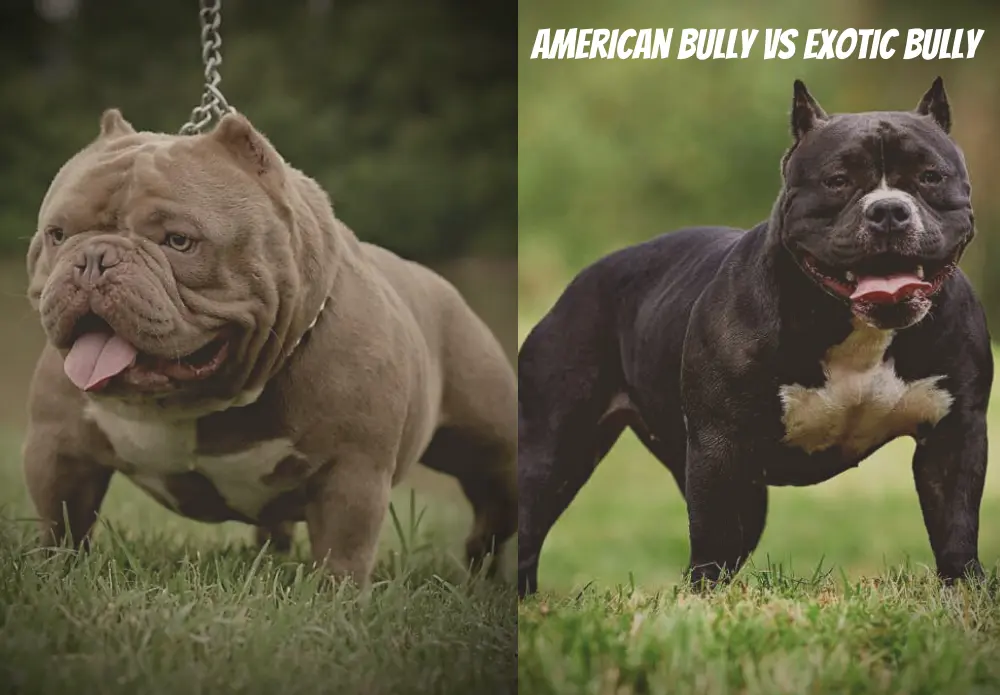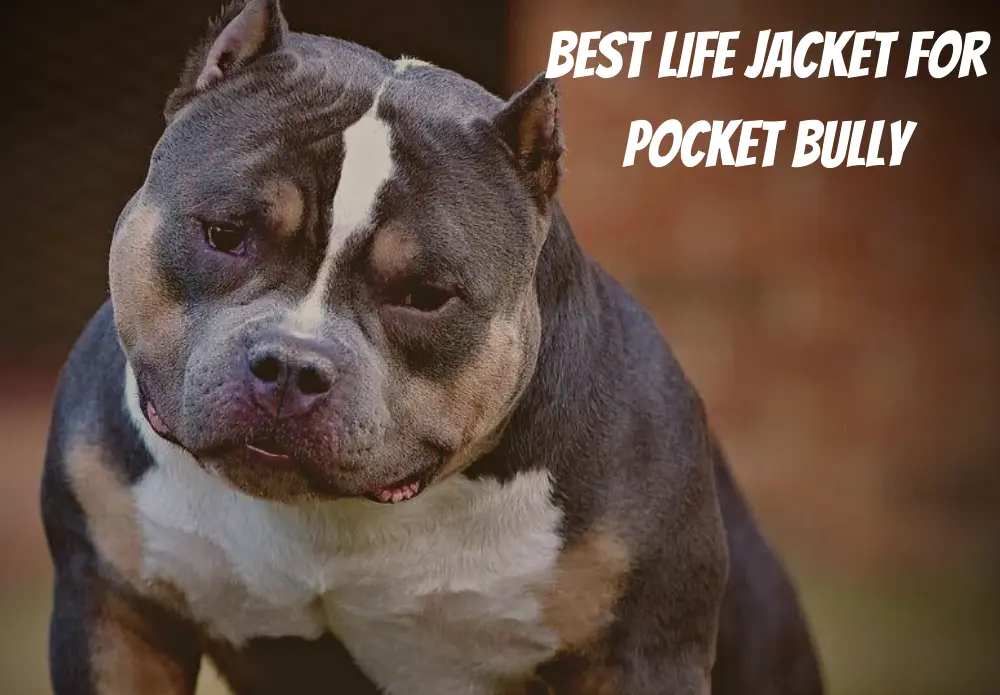It’s not a simple decision to decide to raise a bully breed. If you’re not careful, they can be quite a nuisance. Understanding the differences between the various breeds is essential to choose a dog with the best characteristics.
History of Origin
American Bully
The American Bully is a new breed that gained fame in a few decades. The American Bully was bred between 1980-1990, and unlike the Pitbull, this breed was created to become a family pet dog.
American Bullies are friendly and gained quick fame thanks to their build and variety in size. The American is a result of mixing the American Staffordshire Terrier, American Pitbull Terriers, and American Bulldogs with a few other breeds.
American Bullies are known for their amiable nature, especially with children. The aggressiveness associated with their ancestors was bred out of them through selective breeding and proper training.
Exotic Bully
However, there is little consistency because the Exotic Bully breed is still evolving and was only officially recognized in 2008 by breed associations. The Exotic Bully mixes American Bully, an American Bulldog, and French Bulldog. The main breed indicators are size and overall stature.
The American Kennel Club does not recognize the Exotic Bully formally, so it’s technically a designer breed. This breed exhibits many recognizable bully characteristics but in smaller, exaggerated versions.
Exotic Bully vs American Bully
People wonder whether these two breeds vary in any way. At the same time, they are comparable and distinct. They appear to have different looks, but they share the same nature. Keep reading this article; you can learn about the differences between these two and their shared characteristics.
Looks
As similar as they sound and may look at first glance, they look different. You will see the clear difference if you put them next to each other. They have different body structures, various sizes, and different coats.
Appearance
It’s common to mistakenly identify both breeds at first look, particularly if you don’t know anything about them. However, you can quickly identify them by their outward appearance once you know them.
Although both breeds have broad heads and muscular bodies, Exotic Bully’s heads are marginally larger. An exotic Bully is comparable to an overdone American Bully in some respects.
Compared to American Bully, they have much more exaggerated characteristics like wrinkled faces, more muscle, flatter faces, and shorter muzzles.
Height and Weight
Compared to an American Bully, Exotic Bullies appear smaller in height. Compared to their closest cousins, they are lower to the earth.
American Bullies typically stand 16 to 20 inches tall and weigh 40 to 130 pounds. Exotic bullies, however, are well under 17 inches and measure between 30 and 50 pounds. However, the American Bully has four official classes into which it is divided. These are Standard, Classic, Pocket, and XL Bullies.
Standard American Bully grows tall at 17 to 20 inches and weighs 50 to 75 pounds. Officially the smallest size is the Pocket Bully, which is no smaller than 14 inches and no bigger than 17 inches; it can up to 50 pounds.
Classic has the same height as a standard bully but weighs less at 50 to 65 pounds, and XL Bullies are the biggest, standing at 21 inches to 24 inches and weighing 80 to 130 pounds.
Both dog breeds consume a lot of food due to their elevated energy levels. Due to their smaller stature, particularly Exotic Bully, this makes them more prone to weight gain. As a result, never overfeed your dog.
Even if you aim to give your puppy nutrient-rich food that promotes growth, it is wrong to allow them to consume far more than they ought to.
The Muscular Build
Both types are built with muscles. Compared to American Bully, Exotic Bullies have a stockier build and a brawnier figure. The American Bully’s body bulk gives them a beefy, hulking appearance, but the Exotic Bullies look the best overall. Despite being small, they have a larger amount of body fat.
Unquestionably, this breed has the most muscle. You can see strength and dominance when an American Bully walks down the street. However, Exotic Bully has a leg up on American Bully. When you see an Exotic Bully walking through the streets, you get the impression that a fighter is returning from a victory. Or a bodybuilder just returned from the gym.
Coat
The coats of the two breeds are comparable. They lack an undercoat and have short hair with smooth bodies. The hair is uniformly short and short all over. The surface has a soft, lustrous finish. Since they only have a single coat, they can’t live in frigid climates.
Since they are not prone to tangles and hair ties, grooming is not difficult. A rubber mitt and a fine-tooth comb are the best tools to brush their hair. Their coat will appear shiny if you give them a once-over every so often.
Lifespan
Both Exotic and American Bullies are similar but don’t live the same. This is because these dogs are muscular and can easily get overweight.
American Bullies can live up to 8-15 years, whereas Exotic Bullies live less at 8 to 10 years. Both breeds need daily exercise as they can easily put on weight and become obese.
Sexual Maturity
For Male American Bullies and Exotic Bullies
Like any male dog, male Exotic and American Bullies become fertile as they age six months. However, it is advised to wait until 12 months old before breeding them.
When they are between 12 and 15 months old, they become sexually mature. Both males and females of either breed can become pregnant at any time of the year if the male is in good condition.
Once they reach sexual development, bullies can mate at any time of the year. Male dogs in their senior years are still fertile and sexually active. One thing to note is that Exotic Bullies’ extra muscular physique limits them from mating. For this reason, semen is often taken through artificial methods.
For Female American Bullies and Exotic Bullies
All breeds of female dogs typically reach sexual maturity at 6 to 24 months. Anytime after their sixth month of life, they experience their first menstrual period. It is advised to breed females of both types following their initial heat cycle.
The American Bullies can have three to four heat cycles per year due to their tiny size. Exotic Bully females have comparable heat cycles to American Bullies, despite being slightly larger than Bullies.
Just like the male counterparts of Exotic Bullies, females cannot be impregnated naturally, so artificial insemination is the go-to method. The puppies are also born through a c-section.
The Temperament of American Bullies and Exotic Bullies
Exotic Bullies and American Bully both have similar temperaments. Both canine breeds are friendly, affectionate animals who get along well with families and kids. They are a popular option for companion dogs due to their quirky personalities.
Both canines have a lot of energy, but American Bullies typically have more of it. To help them release their energy, always come up with tasks and take them for a walk or an exercise session. Keeping them inside the house penned up will only lead to frustration and destructive behavior.
Although training the American Bully and Exotic Bully needed a lot of patience, they were also very trainable. This is because bully breeds generally have an obstinate streak.
Therefore, rewards-based training is the most efficient training technique you can use to teach any bully breed.
To have a well-behaved American Bully or Exotic Bully in your neighborhood and the canine community, you must maintain a consistently positive attitude and be dedicated to training.
With Families
American Bullies and Exotic have wonderful relationships with their masters and families. When it comes to intelligence, affection, and loyalty, they have similar qualities.
American Bully was created to develop a loyal, devoted, intelligent, and friendly breed. American Bullies have all these traits and are alert, responsive, owner-pleasers, and quick learners. Exotic Bullies also have these traits but in smaller, more exotic bodies.
They love to please their owner and will do anything to make them happy. Bullies are friendly and tolerant towards children and friends, as they think of them as their own family.
You can even expect tolerance for strangers in your Bully, making them unfit to be guard dogs. However, they can and will defend their family if threatened.
Taking Care of the Dogs
Diet
Both of these breeds have muscular builds and the same nutritional needs. Both need a diet that is high in protein and fat, along with necessary carbohydrates.
The Bullies could eat anywhere from 1.5 to 5 containers daily. It follows that the weekly cost of food may be entirely different or nearly the same. For specific guidance, you should ultimately adhere to the feeding and packaging directions for the food.
Grooming
Thankfully, the coats on both of these puppies are simple to maintain. To keep their straight, short hair appearing healthy and shiny, they only need to be brushed once a week. It will distribute natural coat oils, get rid of dead hair and dirt, and be a relaxing time with your dog.
A short bristle brush would be a wonderful brushing tool for both of these guys. American Bullies and Exotic Bullies both sweat on average. Both do not blow their coats on a seasonal basis, which appeals to many proprietors.
Once every two to three months, both dogs should get baths. Or as and when they require it if they get dirty while on their walkies. Just once every month at most.
It is advised to use a shampoo made for dogs with sensitive skin when shampooing either of these puppies. At least twice a week, they should clean their teeth. Due to their increased risk of periodontal illnesses, you might need more if you have a small Bully.
Health Issues
No matter how healthy an American Bully or an Exotic Bully may be, they still experience health problems like all other dogs. Exotic and American Bullies generally have similar health problems.
Genes or aging are two factors that can contribute to some generic issues. However, some problems are brought on by the owner’s carelessness and starvation. The issues that both types must deal with are as follows:
1. Hip Dysplasia
It is one of the most common health issues among dogs, regardless of breed. After a certain age, this issue arises in every dog. Due to the hip joints’ malformation in this illness, pain is present.
The hip is malformed when the joint and socket rub against each other. The dog’s pain makes it uncomfortable and challenging to move. These are the signs of this illness:
- Body appears thin
- Fewer activities
- Lameness
- Difficulty moving and standing up
2. Thyroid Disease
The Bully family is afflicted by this illness frequently. Do a thyroid disease examination if you suspect your dog is putting on weight and exhibiting skin issues. The dog’s metabolism is impacted when the thyroid glands cannot produce enough thyroid hormones. These are a few signs of the illness:
- Loss of appetite Lethargic.
- Obesity
- Anemia
- Skin conditions
3. Knee Complications
Both of these breeds are extremely energetic and enjoy running. The cranial cruciate ligament is impacted by this exercise, which affects the dogs’ ability to move freely.
This painful health condition causes the dog to limp while walking and starts with a partial tear in the ligament. Usually, the condition worsens due to the dog’s continued physical activity.
4. Cataracts
American Bullies and Exotic Bullies are prone to cataracts more than any other breed. Because it is inherited, Exotic Bullies are more likely to develop this disease than American Bullies.
Diabetes, uveitis, and hypocalcemia are a few other diseases that can result from cataracts. Depending on the cataract’s condition, it may be treated with medicine or surgery.
5. Heart Disease
The parent dogs of both breeds are typically the source of heart illness. Aortic stenosis, which affects the health of both Exotic Bullies and American Bullies, is the most prevalent form of heart disease. This condition has no signs at all. It is advised to regularly have your dog diagnosed early so that treatment can begin promptly.
Exercise
Both dogs require roughly the same amount of activity. They must exercise for 60 minutes daily to be cheerful and healthy. These two men aren’t sofa potatoes. The hefty American Bully included!
The American Bully would be the type of choice if we had to pick one more active than the others. The American Bully requires more cerebral stimulation throughout the day because it is more athletic and agile. Because of their Pitbull and Bulldog ancestry, the Bully enjoys relaxing after workouts.
Choose a durable toy that can endure their constant play because both breeds are tenacious and rough. Both Bullies are considered a little smarter, so buy them some puzzle games to keep them occupied. You shouldn’t have a bored dog on your hands if you keep their exercise diverse and give them interactive play.
Keeping them both on leashes when out in public is recommended due to their feared reputation. All dogs have a certain amount of unpredictable behavior, even though they aren’t the aptest to cause trouble.
Whatever dog you select, you should also research the BSL regulations in your area. According to some states’ laws, bully-type dogs must be muzzled in public, and some do not allow entrance to doggy parks.
Training
Both dogs have slightly varying training requirements and capacities. Bullies are intelligent and anxious to please dogs that respond well to training. He is suitable for new dog owners with a little study on dog training.
Again, the Bully can be a little more obstinate and defiant because of his Bulldog ancestry. Exotic Bullies need a more seasoned dog owner who can harness their independence and bring out the best in them.
Both of these dogs need to be socialized from the beginning. Before you bring the dog home, a good breeder will begin teaching them. Then it will be up to you to carry on. You should combine the two with as many pets and people as possible.
Additionally, expose them to various sights, noises, and smells. Positive reinforcement teaching works best for both dogs, so look into it and apply it.
No dog should ever be subjected to harsh handling or teaching methods. This is particularly true for strong dogs like these since crossing the two can result in dangerous dogs. Learn what inspires your dog the most. Treats will likely motivate the American Bully, and trinkets will likely encourage the Exotic Bully.
Both dogs yearn for human company. It is impossible to be with them constantly, no matter how much we would like to and how much they merit it.
All dogs should be trained to use crates, but those prone to separation anxiety should be taught the most. Since all dogs need shelter, find the ideal dog crate for Bullies. I also predict that your “mean” Bully-type dog will take his favorite toys inside.
Puppy Prices
A Micro Bully, a small unofficial class of American Bully, costs almost as much as an Exotic Bully in price. Exotic Bully is a relatively new breed, and finding a breeder who will properly and responsibly breed one is challenging. This is the same reason Micro Bully is so expensive.
Exotic Bully prices typically start at $5,000 but can easily reach $10,000 or more based on size, coat color, and appearance. You can buy an American Bully for an average price of $2,000 to $8,000 because they already have a normal breeding standard.
FAQs – Frequently Asked Questions
What is Considered an Exotic Bully?
An Exotic Bully is the same as an American Bully but more muscular and exaggerated in a smaller size. The Exotic Bully results from breeding American Bullies with French, American Bulldogs, and Staffordshire Terriers.
What 2 Breeds Make an American Bully?
The America Pitbull Terrier was crossbred with Staffordshire Terrier and various Bulldog-type dogs to make the American Bully. The purpose of breeding American Bully is to produce a strong, muscular dog with the looks of a Pitbull but none of the aggression.
Conclusion
In conclusion, both the American and Exotic Bully breeds make wonderful family companion dogs, despite having comparable but distinct features. Furthermore, despite their outward appearances and the stereotype surrounding them, both canines are kind, friendly, and affectionate.
They can establish close relationships with their human relatives. Additionally, they are wonderful around kids. Despite which breed you have, you’re assured of getting an adorable and loving companion who will always be eager to spend time with you.






